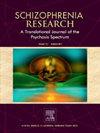Polygenic risk score of glycemic homeostasis, Type 2 Diabetes Mellitus and glycemic components in first episode psychosis
IF 3.5
2区 医学
Q1 PSYCHIATRY
引用次数: 0
Abstract
Objective
First episode of psychosis (FEP) is associated with glucose homeostasis abnormalities even before pharmacological intervention. Given inconclusive GWAS results regarding a direct genetic link between schizophrenia and type 2 diabetes mellitus (T2DM), we hypothesized that FEP patients may exhibit altered genetic risk for glycemic traits. We compared polygenic risk scores (PRS) for T2DM (PRST2DM), fasting glucose (PRSFG), and glycated hemoglobin (HbA1c) (PRSHbA1c) between FEP patients and controls, examining their associations with glycemic measures over 24 months.
Methods
We analyzed data from 242 FEP patients and 119 controls, assessing fasting serum glucose and HbA1c at baseline and 24 months. We examined cross-sectional and longitudinal associations between PRS and glycemic measures within each group.
Results
FEP patients and controls did not differ significantly in PRS. Significant associations were observed for PRSFG with baseline serum glucose in controls (p = 0.008), PRSFG during follow-up (p = 0.034), PRSHbA1c at 24 months (p = 0.018), and HbA1c longitudinally (p = 0.025). After multiple testing corrections, only the association between PRSFG and baseline serum glucose in controls remained significant (p_adj = 0.023). No associations were found for PRST2DM.
Conclusions
Despite the link between FEP and glycemic disturbances, PRST2DM did not differ between FEP patients and controls. However, PRS for glycemic traits showed associations with glycemic measures in both groups before multiple testing correction, suggesting that genetic predisposition may influence glucose homeostasis in early psychosis. The absence of a direct association between common genetic variants underlying T2DM and early glycemic dysregulation in FEP underscores the importance of considering environmental factors and epigenetic mechanisms.
首发精神病患者血糖稳态、2型糖尿病和血糖成分的多基因风险评分
目的在药物干预前,首次精神病发作(FEP)与葡萄糖稳态异常有关。鉴于GWAS关于精神分裂症和2型糖尿病(T2DM)之间的直接遗传联系的不确定结果,我们假设FEP患者可能表现出血糖特征的遗传风险改变。我们比较了FEP患者和对照组的T2DM (PRST2DM)、空腹血糖(PRSFG)和糖化血红蛋白(HbA1c)的多基因风险评分(PRS),研究了它们与24个月血糖测量的关系。方法分析242例FEP患者和119例对照组的数据,评估基线和24个月的空腹血糖和HbA1c。我们检查了每组中PRS和血糖测量之间的横断面和纵向关联。结果fep患者与对照组的PRS无显著差异。PRSFG与对照组基线血糖(p = 0.008)、随访期间PRSFG (p = 0.034)、24个月时PRSHbA1c (p = 0.018)和纵向HbA1c (p = 0.025)存在显著相关性。经过多次测试校正,只有对照组的PRSFG和基线血糖之间的相关性仍然显著(p_adj = 0.023)。未发现与PRST2DM相关。结论:尽管FEP与血糖紊乱之间存在联系,但在FEP患者和对照组之间PRST2DM没有差异。然而,在多次测试校正之前,两组的血糖特征PRS显示与血糖测量相关,这表明遗传易感性可能影响早期精神病的葡萄糖稳态。T2DM常见遗传变异与FEP早期血糖失调之间缺乏直接关联,这强调了考虑环境因素和表观遗传机制的重要性。
本文章由计算机程序翻译,如有差异,请以英文原文为准。
求助全文
约1分钟内获得全文
求助全文
来源期刊

Schizophrenia Research
医学-精神病学
CiteScore
7.50
自引率
8.90%
发文量
429
审稿时长
10.2 weeks
期刊介绍:
As official journal of the Schizophrenia International Research Society (SIRS) Schizophrenia Research is THE journal of choice for international researchers and clinicians to share their work with the global schizophrenia research community. More than 6000 institutes have online or print (or both) access to this journal - the largest specialist journal in the field, with the largest readership!
Schizophrenia Research''s time to first decision is as fast as 6 weeks and its publishing speed is as fast as 4 weeks until online publication (corrected proof/Article in Press) after acceptance and 14 weeks from acceptance until publication in a printed issue.
The journal publishes novel papers that really contribute to understanding the biology and treatment of schizophrenic disorders; Schizophrenia Research brings together biological, clinical and psychological research in order to stimulate the synthesis of findings from all disciplines involved in improving patient outcomes in schizophrenia.
 求助内容:
求助内容: 应助结果提醒方式:
应助结果提醒方式:


